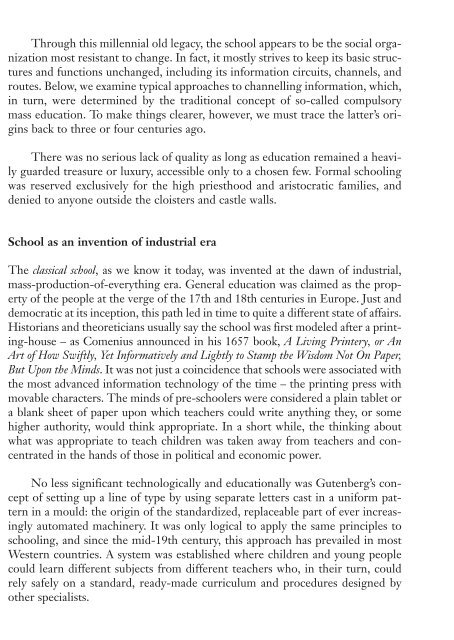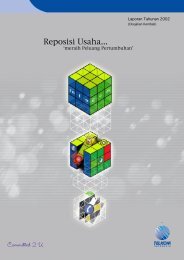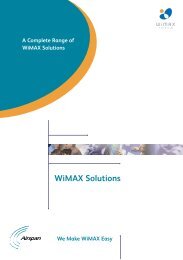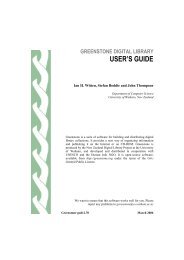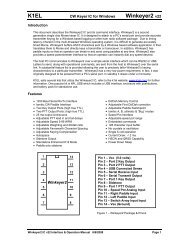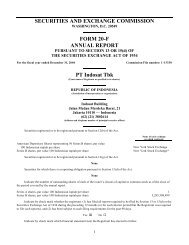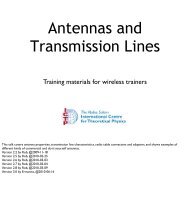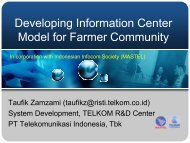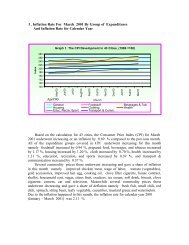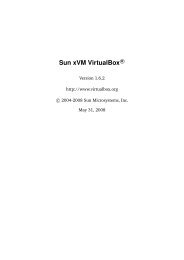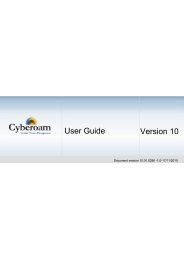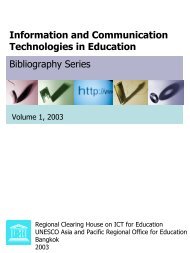Information and communication technologies in schools: a ...
Information and communication technologies in schools: a ...
Information and communication technologies in schools: a ...
Create successful ePaper yourself
Turn your PDF publications into a flip-book with our unique Google optimized e-Paper software.
Through this millennial old legacy, the school appears to be the social organization<br />
most resistant to change. In fact, it mostly strives to keep its basic structures<br />
<strong>and</strong> functions unchanged, <strong>in</strong>clud<strong>in</strong>g its <strong>in</strong>formation circuits, channels, <strong>and</strong><br />
routes. Below, we exam<strong>in</strong>e typical approaches to channell<strong>in</strong>g <strong>in</strong>formation, which,<br />
<strong>in</strong> turn, were determ<strong>in</strong>ed by the traditional concept of so-called compulsory<br />
mass education. To make th<strong>in</strong>gs clearer, however, we must trace the latter’s orig<strong>in</strong>s<br />
back to three or four centuries ago.<br />
There was no serious lack of quality as long as education rema<strong>in</strong>ed a heavily<br />
guarded treasure or luxury, accessible only to a chosen few. Formal school<strong>in</strong>g<br />
was reserved exclusively for the high priesthood <strong>and</strong> aristocratic families, <strong>and</strong><br />
denied to anyone outside the cloisters <strong>and</strong> castle walls.<br />
School as an <strong>in</strong>vention of <strong>in</strong>dustrial era<br />
The classical school, as we know it today, was <strong>in</strong>vented at the dawn of <strong>in</strong>dustrial,<br />
mass-production-of-everyth<strong>in</strong>g era. General education was claimed as the property<br />
of the people at the verge of the 17th <strong>and</strong> 18th centuries <strong>in</strong> Europe. Just <strong>and</strong><br />
democratic at its <strong>in</strong>ception, this path led <strong>in</strong> time to quite a different state of affairs.<br />
Historians <strong>and</strong> theoreticians usually say the school was first modeled after a pr<strong>in</strong>t<strong>in</strong>g-house<br />
– as Comenius announced <strong>in</strong> his 1657 book, A Liv<strong>in</strong>g Pr<strong>in</strong>tery, or An<br />
Art of How Swiftly, Yet Informatively <strong>and</strong> Lightly to Stamp the Wisdom Not On Paper,<br />
But Upon the M<strong>in</strong>ds. It was not just a co<strong>in</strong>cidence that <strong>schools</strong> were associated with<br />
the most advanced <strong>in</strong>formation technology of the time – the pr<strong>in</strong>t<strong>in</strong>g press with<br />
movable characters. The m<strong>in</strong>ds of pre-schoolers were considered a pla<strong>in</strong> tablet or<br />
a blank sheet of paper upon which teachers could write anyth<strong>in</strong>g they, or some<br />
higher authority, would th<strong>in</strong>k appropriate. In a short while, the th<strong>in</strong>k<strong>in</strong>g about<br />
what was appropriate to teach children was taken away from teachers <strong>and</strong> concentrated<br />
<strong>in</strong> the h<strong>and</strong>s of those <strong>in</strong> political <strong>and</strong> economic power.<br />
No less significant technologically <strong>and</strong> educationally was Gutenberg’s concept<br />
of sett<strong>in</strong>g up a l<strong>in</strong>e of type by us<strong>in</strong>g separate letters cast <strong>in</strong> a uniform pattern<br />
<strong>in</strong> a mould: the orig<strong>in</strong> of the st<strong>and</strong>ardized, replaceable part of ever <strong>in</strong>creas<strong>in</strong>gly<br />
automated mach<strong>in</strong>ery. It was only logical to apply the same pr<strong>in</strong>ciples to<br />
school<strong>in</strong>g, <strong>and</strong> s<strong>in</strong>ce the mid-19th century, this approach has prevailed <strong>in</strong> most<br />
Western countries. A system was established where children <strong>and</strong> young people<br />
could learn different subjects from different teachers who, <strong>in</strong> their turn, could<br />
rely safely on a st<strong>and</strong>ard, ready-made curriculum <strong>and</strong> procedures designed by<br />
other specialists.<br />
Schools <strong>in</strong> Transition<br />
99


